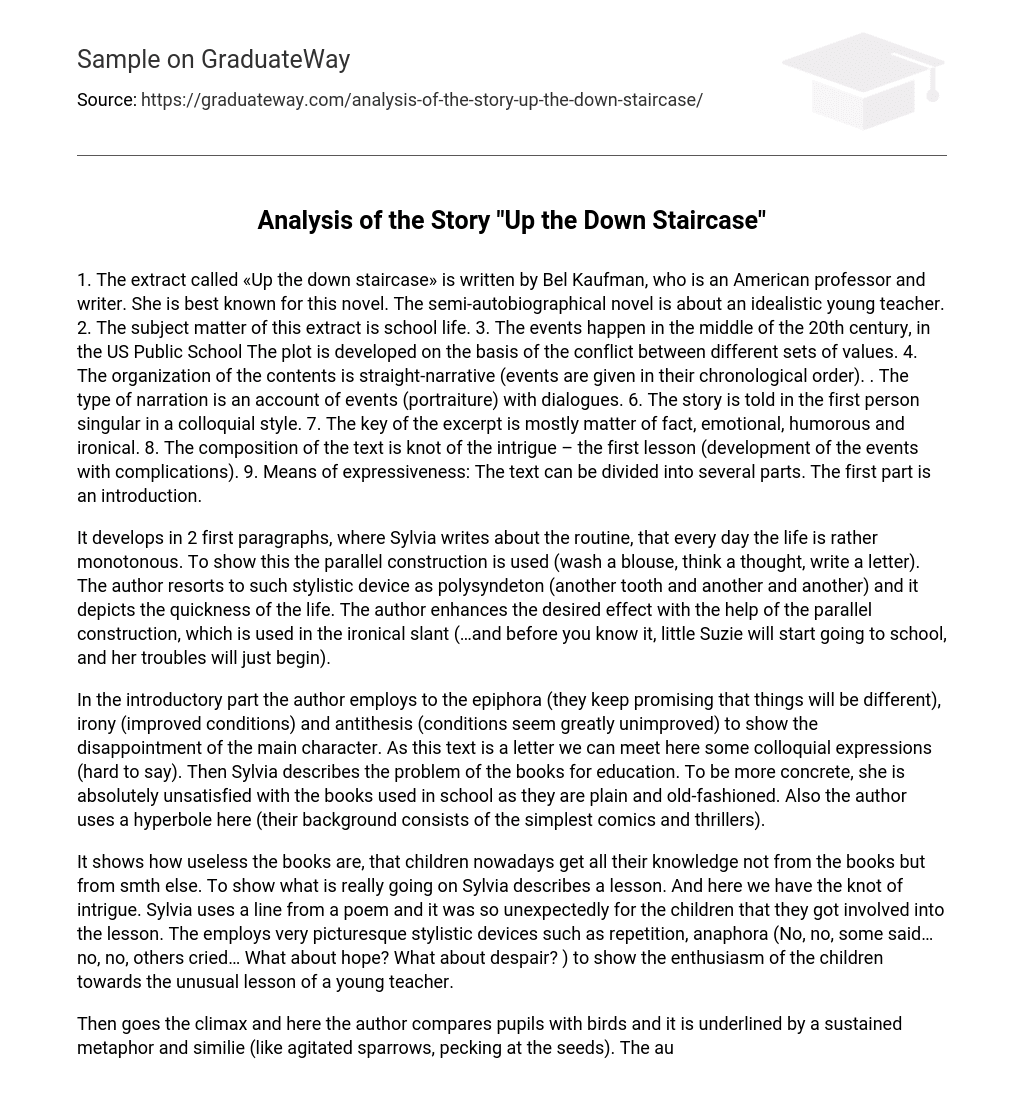1. The extract called «Up the down staircase» is written by Bel Kaufman, who is an American professor and writer. She is best known for this novel. The semi-autobiographical novel is about an idealistic young teacher. 2. The subject matter of this extract is school life. 3. The events happen in the middle of the 20th century, in the US Public School The plot is developed on the basis of the conflict between different sets of values. 4. The organization of the contents is straight-narrative (events are given in their chronological order). . The type of narration is an account of events (portraiture) with dialogues. 6. The story is told in the first person singular in a colloquial style. 7. The key of the excerpt is mostly matter of fact, emotional, humorous and ironical. 8. The composition of the text is knot of the intrigue – the first lesson (development of the events with complications). 9. Means of expressiveness: The text can be divided into several parts. The first part is an introduction.
It develops in 2 first paragraphs, where Sylvia writes about the routine, that every day the life is rather monotonous. To show this the parallel construction is used (wash a blouse, think a thought, write a letter). The author resorts to such stylistic device as polysyndeton (another tooth and another and another) and it depicts the quickness of the life. The author enhances the desired effect with the help of the parallel construction, which is used in the ironical slant (…and before you know it, little Suzie will start going to school, and her troubles will just begin).
In the introductory part the author employs to the epiphora (they keep promising that things will be different), irony (improved conditions) and antithesis (conditions seem greatly unimproved) to show the disappointment of the main character. As this text is a letter we can meet here some colloquial expressions (hard to say). Then Sylvia describes the problem of the books for education. To be more concrete, she is absolutely unsatisfied with the books used in school as they are plain and old-fashioned. Also the author uses a hyperbole here (their background consists of the simplest comics and thrillers).
It shows how useless the books are, that children nowadays get all their knowledge not from the books but from smth else. To show what is really going on Sylvia describes a lesson. And here we have the knot of intrigue. Sylvia uses a line from a poem and it was so unexpectedly for the children that they got involved into the lesson. The employs very picturesque stylistic devices such as repetition, anaphora (No, no, some said… no, no, others cried… What about hope? What about despair? ) to show the enthusiasm of the children towards the unusual lesson of a young teacher.
Then goes the climax and here the author compares pupils with birds and it is underlined by a sustained metaphor and similie (like agitated sparrows, pecking at the seeds). The author also compares one of the teachers «Admiral Ass» with a donkey and here we can see antonomasia. In reality he is very powerful person and as stubborn as a donkey. Then the author describes her speculation on what can be done at school and this effect is strengthened with allusions to the Bible (the cardinal sin, the Enemy), irony (Requisition Forms) and inversion (enter Admiral Ass).
The next passage is devoted to the stuff. Through the usage of colloquial speech (on one foot) the author shows us the disorderliness of the teachers at this school. Anaphora (brilliantly endowed teachers), metaphors (work their magic in their classroom; excuse or a refuge), bitter irony (Those, who can, do, those, who can’t, teach) and cases of epithets (bitter, misguided) also can be seen in this very passage. The last passage resorts us to the portraiture of the Chairman of the English Department, Dr. Bester and this is the case of antonomasia.
The author masterfully describes him employing a very picturesque epithets (He is a dour, desiccated little man, remote and prissy) and a case of metaphor (The ghost walks) is also used here in order to show the readers that this is the only person at school, who can make the kids to be frightened. Pupils respect him and teachers dislike him. Principles of foregrounding: * Convergency * Contrast 10. The message of the text is to demonstrate that there is no system of education at public schools in the USA.





